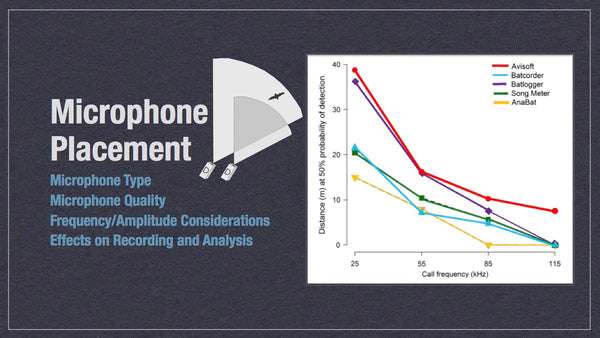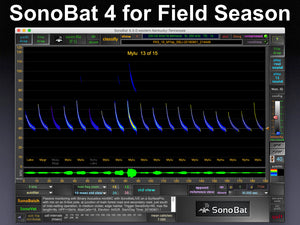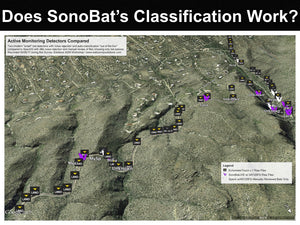Tips for Siting Bat Detectors

Deploying detectors is more involved than simply picking up an “approved” ultrasonic recorder and sticking it out in the woods and turning it on to record. Properly siting a bat detector is every bit as important as properly siting a mist net . . . maybe more so. After all, it’s easy for us to visualize how bats might travel thru a flyway and how best to intercept them. It’s more difficult perhaps for us to conceptualize how bats use echolocation to navigate thru their habitats, and how that high-frequency sound travels thru air and is impacted by physical, environmental, and anthropogenic structures.
First and foremost . . . Don’t put detectors on the ground. Bats don’t often fly within 1-2 meters of the ground. And if they do, they will be producing those undesirable approach-phase echolocation call characteristics that are less diagnostic. The ground will provide a lot of interference from echo and differential air temperatures that will negatively affect the quality of your recordings.
Don’t deploy detectors in amongst highly cluttered habitats, even if you are targeting species that are “clutter-specialists.” It’s far better to deploy detectors in open or edge habitats or where closed-in flight corridors open up. Find a way to let microphones listen into the environment without becoming a novel object bats would be attracted to. This is because bats appear to be intensely curious about novel items in their airspace, and will produce non-standard calls during these investigations. Species tend to overlap with each other often leading to misidentification. This can happen anywhere, anytime, so if species identification is important, avoid high traffic bat areas such as roosts, hibernacula, and even foraging hotspots.
Finally, just as you would not record an interview in a noisy train station, be aware of ambient ultrasonic noise occurring in your environment that could drown out bat calls. To make matters worse this interference may not be apparent until after dark when insects and peepers start calling or when powerlines get wet.
Microphone frequency and response. To give you an idea of the wide variability in microphone types and how they respond to different high-frequencies at different distances, consider the graph below which appeared in a recent journal article co-authored by Brock Fenton. Five different detectors/microphones with their distance for response plotted on the vertical axis and the frequency of input across the horizontal.
Both the Avisoft and Batlogger mics are responsive to a 25kHz sound at nearly 40 meters. Batcorder and SongMeter mics first pick up a 25kHz sound at HALF that distance, 20 meters. And AnaBats are even slightly less responsive than this at about 15 meters.
As sound frequency increases to 55kHz (a critical frequency for recording high-quality Myotis sequences), detection distance decreases . . . to just below 20 meters for the Avisoft and Batlogger models and less than 10 meters for the rest of the brands.
And, at upper frequencies above 115kHz, none of the detectors except the Avisoft, will respond, even if the bat is nearly right on top of the unit. This has important ramifications for anyone trying to collect MYOSEP calls that can be confidently identified. Unfortunately the Pettersson D500 was not included in this test, but in other instances we have found the D500x microphone to be slightly more responsive than the Batlogger mic. Of course, this is a lab trial with several kinds of technologies and microphone hardware. The good news is since bats always approach microphones from random directions, differences in hardware are simply mitigated by increasing the sampling time, and often that time is already incorporated into many sampling protocols. These comparisons are to illustrate obvious differences in sound quality only, examples do not necessarily reflect results at all times.

And it’s not just the sensitivity and the frequency response, but it’s also the inherent noise floor of the microphone element.The D500x is a nice quiet microphone, as evidenced by the clearly defined oscillographic representation from a D500x microphone in the top of this diagram. A side-by-side deployment of an SMX-UT microphone (outfitted with a directional horn) is shown below it for the same bat pass. You can see that most of the frequencies present in the bat call are buried in the broad noise band of the microphone.

When we look at the spectrographs from these two passes, we can see how clean and clear the D500x sequence is at the top. And, the increased frequency response of the D500x microphone results in more of the upper frequencies of each bat pulse being captured. The sequence recorded from the SMX-UT mic on the bottom is less fully rendered and more of the upper frequencies are obscured by the noise inherent in the microphone, indicated by the snowy band across the top. Note that the the SMX-UT as well as all other microphones prior to the SMX-U1 has been discontinued by the manufacturer; BCM strongly recommends for professional surveys only the SMX-U1 microphone be used, without the supplied windscreen for best sound quality from those devices. These comparisons are to illustrate obvious differences in sound quality only, examples do not necessarily reflect results at all times.

But bats rely upon water sources for feeding and drinking, so they are excellent areas to survey for bats, of course. Avoid areas with rushing water as some detectors will falsely trigger on the ultrasound generated by riffles and waves. So pooled water sources that bats prefer to drink out of are also highly reflective to sound, and reflected echoes from echolocation calls have the potential to interfere with the originating pulses and render calls sequences impossible to identify.
Ideally a microphone should be far enough from reflective sources (e.g., smooth reflective surfaces like flat, pooled water surfaces; concrete pavement; metal roofs/buildings; etc.) to make sure that any echo is sufficiently delayed so as to not overlap the original echolocation. As shown in the sequence below, echoes are shown nearly masking the original pulses. To reduce this possibility when detecting at pooled water sources, elevate your mic at LEAST 12 feet off the water, but over 30-feet would be ideal to get a 30 ms gap between the initial call pulse and the echo. This will never eliminate all echos overlapping because bats come and go from random directions, but it will greatly increase the number of files that can be analyzed.

Below is a spot I managed to pick up a bunch of Northern long ear calls. Place your microphone in the center of airspace of where you expect bats to fly thru. In this case, any higher than 12’ or so starts putting you in the overhanging brush. But the consideration to look for is the curve in the road. When walking around the curve you get to a point where the mic is looking straight down the middle of the road. Using a directional mic, the response will be more sensitive to the middle of the road and can record some longer sequences as the bat flies right towards (or away from) the mic.

No “omnidirectional” microphone ever truly has the same frequency response around the entire microphone; it is of course optimized for sound in front of the element and most frequencies lose up to 10 dB around the sides of the mic. Yes, you may record more -files- with a omnidirectional mic, but probably more of them will be low quality and not useful for species ID, resulting in a higher data burden.
On the decibel scale, the smallest audible sound (near total silence) is 0 dB. A sound 10 times more powerful is 10 dB. A sound 100 times more powerful than near total silence is 20 dB. A sound 1,000 times more powerful than near total silence is 30 dB.
Below is a polar plot showing the response of a D500x microphone at 4 different frequency levels, with the tiny directional “horn” removed.
Adding a directional horn to the element changes things dramatically. Here the blue 20 kHz line holds its own only losing 5-10 dB even when a hoary bat is directly behind the microphone element. However, the higher frequencies progressively become worse as the bat travels around the directional horn. However, you may actually record better sounds overall because that directional horn is concentrating reception and reaching further out in front of the mic.

If you use only one kind of bat detector microphone, you are only getting one opinion on the bat species in your area. There is fascinating variability when comparing and evaluating side-by side deployment efforts and recordings. Below is an example of a trial pitting the standard (for the day) Time-expansion detector with some of the newer direct-recording units with their particular microphones: An “internal” e.g., on-board microphone, an external “hemispherical” microphone, and an external “omnidirectional” microphone. By comparing the number of call files recorded with each, you start to get an idea of relative volumes of detection for each microphone.
The TE microphone, though of excellent quality, is only operational when not time-expanding the call, then it must offload data for 17 seconds before it is ready to record again. So expectedly, it returned fewer calls. Directional mics were next with 84 calls, and Hemispherical mics have greater volumes of detection and recorded 100 calls. Omni-directional mics have the greatest volume of detection and recorded 135 calls, nearly twice that of a directional mic.
But, number of calls doesn’t tell the whole story. The quality of the calls is also important, especially to determine identification for occupancy. When we look at the net number of identifible calls, we see that the hemispherical mic and the directional mic actually have more of the high-quality calls we are after.
And then when we look at “efficiency” the relative percentage of ID’able calls (e.g., how long it takes you to page thru the junk to find the good stuff . . . Either manually or automatically) then the quality and responsiveness of the mic combine to show that the D500x is the best, in this particular instance.

Weatherproofing. Because the inventors of bat detectors never really intended the devices to be left out unattended, a number of after-market hacks have been employed. Be aware that any weatherproofing is going to introduce unintended consequences on your recordings. Full spectrum equipment is far more sophisticated than zero-crossing. When you place a full spectrum microphone in a tube, the resulting sonograms are muddy, distorted, and generally unusable. Any surfaces near the microphone will sooner or later introduce unwanted reflections or distortions into the recordings. This can be tree limbs, rocks, the pole the microphone is on, or even the case of the bat detector itself. If you stick an omnidirectional microphone in a tube or next to a reflector, all sorts of acoustic chaos can ensue.
Accessories like a windscreen can negatively impact your recordings as well. The graph below shows a microphone with no foam windscreen (the dotted line across the top), and then tested again with the windscreen. We can see this starts to affect the 40 kHz response, which happens to be where a lot of our bats concentrate their power. When the windscreen is wet, we have a different frequency response curve dropping nearly 10 decibels around 70 kHz. Throughout a single night with just a single bat buzzing your microphone, the data in those files will vary as this microphone becomes soaked with dew. At a minimum, fewer recordings will be quality, and it is a more likely classifiers will reject more files and misclassify species.

So what do we suggest for weatherproofing? First start with a storage box. The reality of these surveys is that you need a box that keeps the microphone, the 25’ cable, rubber bands, duct tape, memory cards, spare batteries, spare fuse, and perhaps an external battery all in one place during storage and transport. This box does double duty to keep your detector weatherproof on site as well. Don’t worry if your detector chassis is not 100% weatherproof, it lives in the storage box anyway.
What we suggest when using any of todays modern microphones is to simply orient them horizontally, if you’re leaving them unattended. Worry more about the connectors becoming soaked, critters chewing on the cord, spiders making webs in the cones, and dew soaking the foam widescreen after a couple hours and torpedoing the data.
If your data is irreplaceable, don’t leave this equipment unattended any longer than you can afford to lose it. Just because your data card can run for 6 months before filling doesn’t mean that’s how long you leave it out. So when you get a new bat detector, take it home and set it up in the back yard for a few hours and offload the data. If it seemed to work, leave it out all night and offload it again. If that worked leave it for a night or two and check on it again. Most detector failures occur in the first few nights of deployment, and checking it often gives you a lot of troubleshooting experience quickly.

- John Chenger






